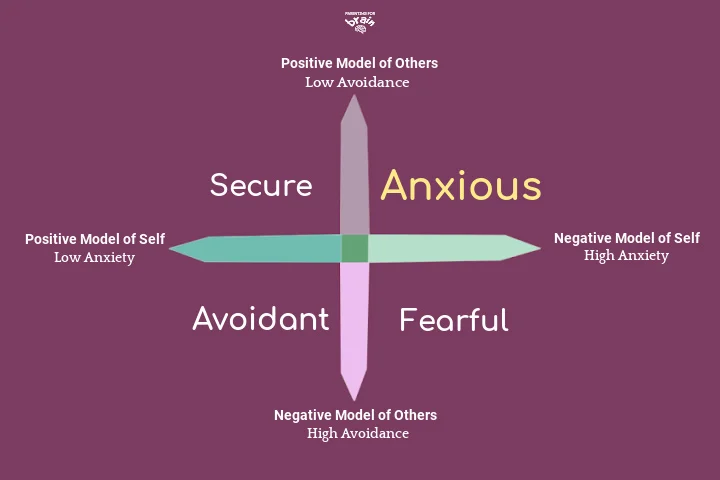- Attachment theory in a nutshell
- What is anxious attachment style
- Causes
- Signs
- Affects relationships
- Affects parenting
- Examples
- How to heal
- How to cope with an anxiously attached spouse
A relationship with a partner who has an anxious attachment style can be challenging and emotionally taxing.
The constant need for validation, frequent messaging, and emotional outbursts can be exhausting, even for the most devoted partner.
To better understand the anxious attachment type, let’s examine the attachment theory.

TABLE OF CONTENTS
- Attachment Theory & attachment styles In A Nutshell
- What Is Anxious Attachment Style
- What Causes Anxious Attachment Style
- Signs of Anxious Attachment Styles in Adults
- How Anxious Attachment Affects Relationships
- How Anxious Attachment Affects Parenting
- Examples of anxious attachment triggers
- How to Heal Anxious Attachment In Yourself
- How to cope with an anxiously attached spouse
- References
Attachment Theory & attachment styles In A Nutshell
Attachment is the strong emotional bond a child forms with their primary caregiver or parents in early childhood.
John Bowlby and Mary Ainsworth’s Attachment Theory suggests that children’s attachment styles have a significant impact on their development and future relationships.
Children develop attachment patterns through childhood experiences, which serve as strategies to stay close to their parents.
These attachment styles shape a child’s internal working models, influencing how they perceive themselves, others, and their relationships.
These models have a lifelong influence on a child’s thoughts, beliefs, and behaviors.
There are four main attachment styles:
- Secure attachment style
- Avoidant attachment style
- Ambivalent or anxious ambivalent attachment style
- Disorganized attachment style
Similarly, adult attachment styles affect their grasp of how romantic relationships work and how conflicts are handled.
The four different attachment styles in adults are:
- Secure attachment style
- Avoidant attachment style
- Anxious attachment style
- Fearful-avoidant attachment style
What Is Anxious Attachment Style
An anxious-ambivalent attachment develops when infants receive inconsistent parenting from their attachment figures. They are uncertain whether or not their caretakers will be there for their emotional needs. Anxious ambivalent attachment is an insecure attachment style.
An anxiously attached child develops internal working models of uncertainty about their caregiver’s help. They often feel insecure and unlovable.
They don’t know whether anyone will want to be close to them.
In adults, the anxious attachment style is also called the preoccupied or anxious-preoccupied attachment style.
An anxious person is high in anxiety because of their uncertainty about their partners’ availability.
They want to be close to others and are low in avoidance.

What Causes Anxious Attachment Style
Children who experience caregivers as emotionally unavailable develop anxiety about their caretakers’ availability, especially during distress1.
These children do not have deep emotional bonds with their primary caregivers.
Oftentimes, it is because these parents are anxiously preoccupied with their own attachment issues2.
Their own attachment style tends to be anxious, too.
In adulthood, a person may perceive that their partner is unreliable or unavailable, and therefore, they anxiously keep track of them.
Signs of Anxious Attachment Styles in Adults
Anxious attachment in adults may carry the following characteristics3.
- Low self-esteem.
- Feelings of insecurity.
- Have a negative view of themselves.
- Feel not worthy of love.
- Strong desire for emotional intimacy.
- Seek constant reassurance and validation from others.
- Overly sensitive to their partner’s availability or rejection cues.
- Intensely jealous or suspicious of their partner.
- Exaggerated negative emotions when partners are unavailable.
- Fear of abandonment.
- Strong fear of rejection.
- Have trust issues.
- Clingy and preoccupied with their relationship.
How Anxious Attachment Affects Relationships
An anxiously attached person yearns to be accepted and validated by their romantic partner.
They have an emotional hunger for love and care.
They believe they would feel secure if only they were understood and appreciated.
Despite being aware of their feelings, these individuals have difficulty self-regulating4.
Anxious adults have a hard time trusting that their significant others will be there for them.
They tend to have more arguments with their partners5.
They get angry and hostile easily when discussing conflicts in their intimate relationships6.
They experience more negative emotions and are more susceptible to breakups7.
Having this type of attachment means they are more sensitive to cues related to their partner’s availability8.
They have a strong desire for emotional closeness and intimacy.
Their need for constant reassurance makes them overly dependent and highly emotional.
The intense fear of abandonment makes these individuals’ judgment of their partner’s actions less accurate.
When people jump to emotional conclusions, they could end up making more mistakes, perpetuating a cycle of conflict and misunderstanding9.
Studies have also found that anxious individuals who raised their younger siblings as children tend to over-parent their romantic partners10.
How Anxious Attachment Affects Parenting
Parents who are anxious and preoccupied tend to parent in a way that interferes with their children’s autonomy or exploration11.
They tend to be overprotective and promote dependency on their children to satisfy their own needs.
These parents are particularly sensitive to infant fear but ignore the infant’s initiatives when playing12.
This type of parent struggles to separate from her toddler.
They are more likely to foster anxiety and deter independence13.
They tend to adopt a hovering parenting style.
They worry about their children’s ability to live independently when they leave for college.
Examples of anxious attachment triggers
Here are some common triggers for anxiously attached individuals.
- A partner does not text or call back.
- Not being warmly welcome when attending a party.
- Feel that if something is not done correctly, others will abandon you.
- People don’t smile when they make eye contact with you.
- A partner does not compliment or express appreciation after you have done something for them.
- Your friend declines your invitation to lunch.
- A partner is having a good time talking to someone else.
- Your best friend travels with another friend without you.
- When a partner needs some space and wants to do things on their own.
- People leave as soon as you arrive.
How to Heal Anxious Attachment In Yourself
Adult life can be difficult for someone who suffers from attachment anxiety.
Acknowledgment
The first step of the healing process is recognizing and embracing the traits of anxiety.
Although it may seem apparent, it is quite challenging to acknowledge their vulnerabilities, such as clinginess or over-sensitivity.
Therefore, it is crucial to understand your attachment style’s role in your adult relationships if you wish to improve it.
Commitment
To bring about change, you must be fully committed to the process.
Only you can change yourself. Others cannot.
Stay true to your commitment, and don’t allow yourself to be deterred when facing challenges or setbacks.
Making sense of your past
Making sense of your past experiences is part of the healing process.
Seeking professional help is one way that can help you gain a better understanding of your past and explore issues related to attachment.
A therapist can also help you reassess and reconstruct your inner representations of interpersonal relationships.
Mindfulness
Mindfulness practices such as meditation can help you improve self-awareness and learn to regulate emotions healthily.
It helps you recognize the difference between perceived and actual threats so that you don’t overreact.
Couple Therapy
Your need for constant validation may push your partner away.
If you or your loved ones have difficulty maintaining a healthy relationship, consider getting couples therapy and working towards a more secure attachment style.
Also See: What Is Anxious-Avoidant Attachment
How to cope with an anxiously attached spouse
Relationships with an anxious partner can be draining.
Encourage them to pursue therapy and commit to the process.
Personal transformation is unattainable unless the individual is genuinely willing to make a change.
A couple’s therapy can also help you cultivate intimate connections without feeling suffocated.
Meanwhile, be patient while your spouse works through these issues to form a secure relationship with you.
With your emotional support, your partner will learn to build a healthier relationship.
References
- 1.Cassidy J, Berlin LJ. The Insecure/Ambivalent Pattern of Attachment: Theory and Research. Child Development. Published online August 1994:971. doi:10.2307/1131298
- 2.Bartholomew K, Shaver PR. Methods of assessing adult attachment: Do they converge? In: Attachment Theory and Close Relationships. The Guilford Press; 1998:25-45.
- 3.Li T, Chan DKS. How anxious and avoidant attachment affect romantic relationship quality differently: A meta-analytic review. Eur J Soc Psychol. Published online January 20, 2012:406-419. doi:10.1002/ejsp.1842
- 4.Oskis A, Clow A, Hucklebridge F, Bifulco A, Jacobs C, Loveday C. Understanding alexithymia in female adolescents: The role of attachment style. Personality and Individual Differences. Published online January 2013:97-102. doi:10.1016/j.paid.2012.08.023
- 5.Levy MB, Davis KE. Lovestyles and Attachment Styles Compared: Their Relations to Each Other and to Various Relationship Characteristics. Journal of Social and Personal Relationships. Published online November 1988:439-471. doi:10.1177/0265407588054004
- 6.Simpson JA, Rholes WS, Phillips D. Conflict in close relationships: An attachment perspective. Journal of Personality and Social Psychology. Published online 1996:899-914. doi:10.1037/0022-3514.71.5.899
- 7.KIRKPATRICK LA, HAZAN C. Attachment styles and close relationships: A four-year prospective study. Personal Relationships. Published online June 1994:123-142. doi:10.1111/j.1475-6811.1994.tb00058.x
- 8.Chris Fraley R, Niedenthal PM, Marks M, Brumbaugh C, Vicary A. Adult Attachment and the Perception of Emotional Expressions: Probing the Hyperactivating Strategies Underlying Anxious Attachment. J Personality. Published online August 2006:1163-1190. doi:10.1111/j.1467-6494.2006.00406.x
- 9.Niedenthal PM, Brauer M, Robin L, Innes-Ker ÅH. Adult attachment and the perception of facial expression of emotion. Journal of Personality and Social Psychology. Published online 2002:419-433. doi:10.1037/0022-3514.82.3.419
- 10.Belsky J. Attachment, mating, and parenting. Hum Nat. Published online December 1997:361-381. doi:10.1007/bf02913039
- 11.Berlin LJ, Cassidy J, Belsky J. Loneliness in young children and infant-mother attachment: A longitudinal study. Merrill-Palmer Quarterly. 1995;41(1):91–103.
- 12.Haft WL, Slade A. Affect Attunement and Maternal Attachment: A Pilot Study. Infant Ment Health J. Published online 1989:157-172.
- 13.Crowell JA, Feldman SS. Mothers’ working models of attachment relationships and mother and child behavior during separation and reunion. Developmental Psychology. Published online 1991:597-605. doi:10.1037/0012-1649.27.4.597
